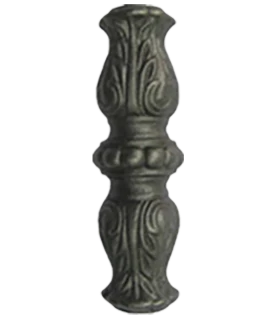Innovative Designs for Efficient Iron Casting Process and Application Techniques
Innovative Designs in Iron Casting A Blend of Tradition and Technology
Iron casting has been a critical part of manufacturing and engineering for centuries, providing durable and versatile components for various applications. As industries evolve, so too do the designs and methods associated with iron casting. Today, innovative techniques and creative design approaches are shaping the future of this age-old craft, resulting in refined products that meet modern demands.
Evolution of Iron Casting
The roots of iron casting can be traced back over 3,000 years, but it has undergone significant transformations since its inception. Traditional sand casting methods laid the groundwork for mass production of iron components. Initially, the craftsmanship relied heavily on skilled artisans who created molds manually, making each piece unique.
However, with the advent of technology, the industry has embraced computer-aided design (CAD) and computer numerical control (CNC) machining, enabling precise and efficient iron casting processes. These innovations streamline production, reduce material waste, and increase the speed of manufacturing, responding swiftly to the ever-changing market needs.
Importance of Design in Iron Casting
Design is a crucial factor in iron casting, determining the functionality, structural integrity, and aesthetic appeal of the final product
. Effective design considerations include the following1. Material Integrity The properties of the iron used, along with the casting method, can significantly influence the final product's strength and durability. Engineers must meticulously account for heat treatment and cooling processes to enhance material properties.
2. Geometric Complexity The versatility of iron casting allows for complex shapes and structures. Advanced design software enables engineers and designers to create intricate models that would have been impossible with traditional methods. This capability opens doors for innovation across various sectors, including automotive, aerospace, and architecture.
3. Weight Optimization Reducing weight without compromising strength is a key consideration in modern design. Utilizing finite element analysis (FEA), designers can optimize the geometry of cast components, ensuring performance while minimizing material usage. Lighter components contribute to energy efficiency in applications like automotive manufacturing.
4. Assembly and Integration Designers also consider how cast components fit into larger systems. Designing with assembly in mind can simplify manufacturing processes and lead to improved product reliability. Elements such as interlocking features and precise tolerances contribute to smoother integration in assemblies.
iron casting designs

5. Aesthetic Considerations While functionality often takes precedence, aesthetics are increasingly important in product design. Designers are experimenting with surface textures, finishes, and colors to enhance the visual appeal of iron castings, particularly in consumer goods and architectural applications.
Sustainable Practices in Iron Casting
As environmental concerns rise, the iron casting industry is also moving toward more sustainable practices. Incorporating recycled materials in the casting process not only reduces waste but also conserves natural resources. Furthermore, advancements in energy-efficient technologies and the use of eco-friendly coatings are helping to minimize environmental impact.
Adopting a circular economy model, where materials are reused and repurposed, is becoming increasingly common. Manufacturers are exploring methods to recycle scrap metal generated during the iron casting process, which helps mitigate the environmental footprint of traditional manufacturing practices.
Future Trends
The future of iron casting design looks promising, with several trends on the horizon
- 3D Printing Additive manufacturing is starting to play a role in the iron casting process. 3D printing technologies allow for rapid prototyping and the production of complex forms that can subsequently be cast in iron.
- Smart Manufacturing The integration of IoT (Internet of Things) in manufacturing processes means that iron casting facilities can monitor and optimize operations in real-time, leading to improved efficiency and product quality.
- Collaborative Design Cross-disciplinary collaboration between engineers, designers, and material scientists is becoming more prevalent. This collaboration facilitates the development of innovative casting solutions that meet specific customer requirements.
In conclusion, the evolution of iron casting design encapsulates a blend of traditional methods and cutting-edge technology. As industries continue to innovate, the designs and techniques associated with iron casting will undoubtedly adapt to meet the challenges of modern manufacturing while preserving the rich heritage of this vital craft. The future holds exciting possibilities, where innovation drives efficiency and sustainability in the iron casting sector.
-
Wrought Iron Components: Timeless Elegance and Structural StrengthNewsJul.28,2025
-
Window Hardware Essentials: Rollers, Handles, and Locking SolutionsNewsJul.28,2025
-
Small Agricultural Processing Machines: Corn Threshers, Cassava Chippers, Grain Peelers & Chaff CuttersNewsJul.28,2025
-
Sliding Rollers: Smooth, Silent, and Built to LastNewsJul.28,2025
-
Cast Iron Stoves: Timeless Heating with Modern EfficiencyNewsJul.28,2025
-
Cast Iron Pipe and Fitting: Durable, Fire-Resistant Solutions for Plumbing and DrainageNewsJul.28,2025
-
 Wrought Iron Components: Timeless Elegance and Structural StrengthJul-28-2025Wrought Iron Components: Timeless Elegance and Structural Strength
Wrought Iron Components: Timeless Elegance and Structural StrengthJul-28-2025Wrought Iron Components: Timeless Elegance and Structural Strength -
 Window Hardware Essentials: Rollers, Handles, and Locking SolutionsJul-28-2025Window Hardware Essentials: Rollers, Handles, and Locking Solutions
Window Hardware Essentials: Rollers, Handles, and Locking SolutionsJul-28-2025Window Hardware Essentials: Rollers, Handles, and Locking Solutions -
 Small Agricultural Processing Machines: Corn Threshers, Cassava Chippers, Grain Peelers & Chaff CuttersJul-28-2025Small Agricultural Processing Machines: Corn Threshers, Cassava Chippers, Grain Peelers & Chaff Cutters
Small Agricultural Processing Machines: Corn Threshers, Cassava Chippers, Grain Peelers & Chaff CuttersJul-28-2025Small Agricultural Processing Machines: Corn Threshers, Cassava Chippers, Grain Peelers & Chaff Cutters












